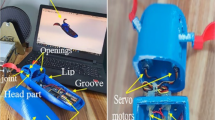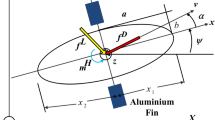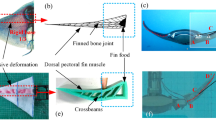Abstract
In present, there are increasing interests in the research on mechanical and control system of underwater vehicles. These ongoing research efforts are motivated by more pervasive applications of such vehicles including seabed oil and gas explorations, scientific deep ocean surveys, military purposes, ecological and water environmental studies, and also entertainments. However, the performance of underwater vehicles with screw type propellers is not prospective in terms of its efficiency and maneuverability. The main weaknesses of this kind of propellers are the production of vortices and sudden generation of thrust forces which make the control of the position and motion difficult.
On the other hand, fishes and other aquatic animals are efficient swimmers, posses high maneuverability, are able to follow trajectories, can efficiently stabilize themselves in currents and surges, create less wakes than currently used underwater vehicle, and also have a noiseless propulsion. The fish’s locomotion mechanism is mainly controlled by its caudal fin and paired pectoral fins. They are classified into Body and/or Caudal Fin (BCF) and Median and/or paired Pectoral Fins (MPF). The study of highly efficient swimming mechanisms of fish can inspire a better underwater vehicles thruster design and its mechanism.
There are few studies on underwater vehicles or fish robots using paired pectoral fins as thruster. The work presented in this paper represents a contribution in this area covering study, design and implementation of locomotion mechanisms of paired pectoral fins in a fish robot. The performance and viability of the biomimetic method for underwater vehicles are highlighted through in-water experiment of a robotic fish.
Similar content being viewed by others
References
Pitowarno E. Robotics: Design, Control, and Artificial Intelligent, Andi Penerbit, Yogyakarta, 2006. (in Indonesian)
Bishop R H. The Mechatronics Handbook, CRC Press, Florida, 2000.
Budiyono A. Advances in unmanned underwater vehicles technologies. International Symposium on Intelligent Unmanned Systems, Nanjing, China, 2008.
Sfakiotakis M, Lane D M, Davies J B C. Review of fish swimming modes for aquatic locomotion. IEEE Journal of Oceanic Engineering, 1999, 24, 237–252.
Kato N, Liu H, Morikawa H. Biology-inspired precision maneuvering of underwater vehicles. International Journal of Offshore and Polar Engineering, 2005, 15, 81–87.
Listak M, Martin G, Pugal D, Aabloo A, Kruusmaa M. Design of a semiautonomous biomimetic underwater Vehicle for environmental monitoring. Proceedings of 2005 IEEE International Symposium on Computational Intelligence in Robotics and Automation, 2005, 9–14.
Lachat D, Crespi A, Ijspeert A J. BoxyBot, the Fish Robot: Design and Realization, EPFL — Semester Project Report, Biologically Inspired Robotics Group (BIRG), 2005.
Muljowidodo, Jenie S D, Budiyono A, Nugroho S A. Recent Progress on Design, Development and Testing of Underwater Vehicles at ITB, Workshop on Underwater System Technology, Putrajaya, Malaysia, 2007.
Muljowidodo, Jenie S D, Budiyono A, Nugroho S A. Design, development and testing of underwater vehicles: ITB experience. The International Conference on Underwater System Technology: Theory and Application, Penang, Malaysia, 2006.
Kato N. Application of study on aqua bio-mechanisms to ocean engineering. Kaiyo Kogaku Shinpojiumu, 2001, 16, 131–138.
Heo S, Wiguna T, Park H, C. Goo N S. Effect of an artificial caudal fin on the performance of a biomimetic fish robot propelled by piezoelectric actuators. Journal of Bionic Engineering, 2007, 4, 151–158.
Tunçdemir Ş, Koç B, Erden A. Design of a swimming mini robot. The 9th Mechatronics Forum International Conference, Ankara, Turkey, 2004.
Lauder G V, Drucker E G. Morphology and experimental hydrodynamics of fish fin control surfaces. IEEE Journal of Oceanic Engineering, 2004, 29, 556–571.
Westneat M, Thorsen D, Walker J, Hale M. Structure, function, and neural control of pectoral fins in fishes. IEEE Journal of Oceanic Engineering, 2004, 29, 674–677.
Mittal R. Computational modeling in biohydrodynamics: Trends, challenges, and recent advances. IEEE Journal of Oceanic Engineerin, 2004, 29, 595–604.
Drucker E, Lauder G. Wake dynamics and fluid forces of turning maneuvers in sunfish. The Journal of Experimental Biology, 2004, 204, 431–442.
Kodati P. Biomimetic Micro Underwater Vehicle with Ostraciiform Locomotion: System Design, Analysis, and Experiments, Master of Science Thesis, Mechanical Engineering Department, University of Delaware, 2006.
Triantafyllou M S, Triantafyllou G S, Gopalkrishnan R. Wake mechanics for thrust generation in oscillating foils. Physics of Fluids A, 1991, 3, 2835–2837.
Anderson J M, Streitlien K, Barrett D S, Triantafyllou M S. Oscillating foils of high propulsive efficiency. Journal of Fluid Mechanics, 1998, 360, 41–72.
Author information
Authors and Affiliations
Corresponding author
Rights and permissions
About this article
Cite this article
Sitorus, P.E., Nazaruddin, Y.Y., Leksono, E. et al. Design and Implementation of Paired Pectoral Fins Locomotion of Labriform Fish Applied to a Fish Robot. J Bionic Eng 6, 37–45 (2009). https://doi.org/10.1016/S1672-6529(08)60100-6
Published:
Issue Date:
DOI: https://doi.org/10.1016/S1672-6529(08)60100-6




